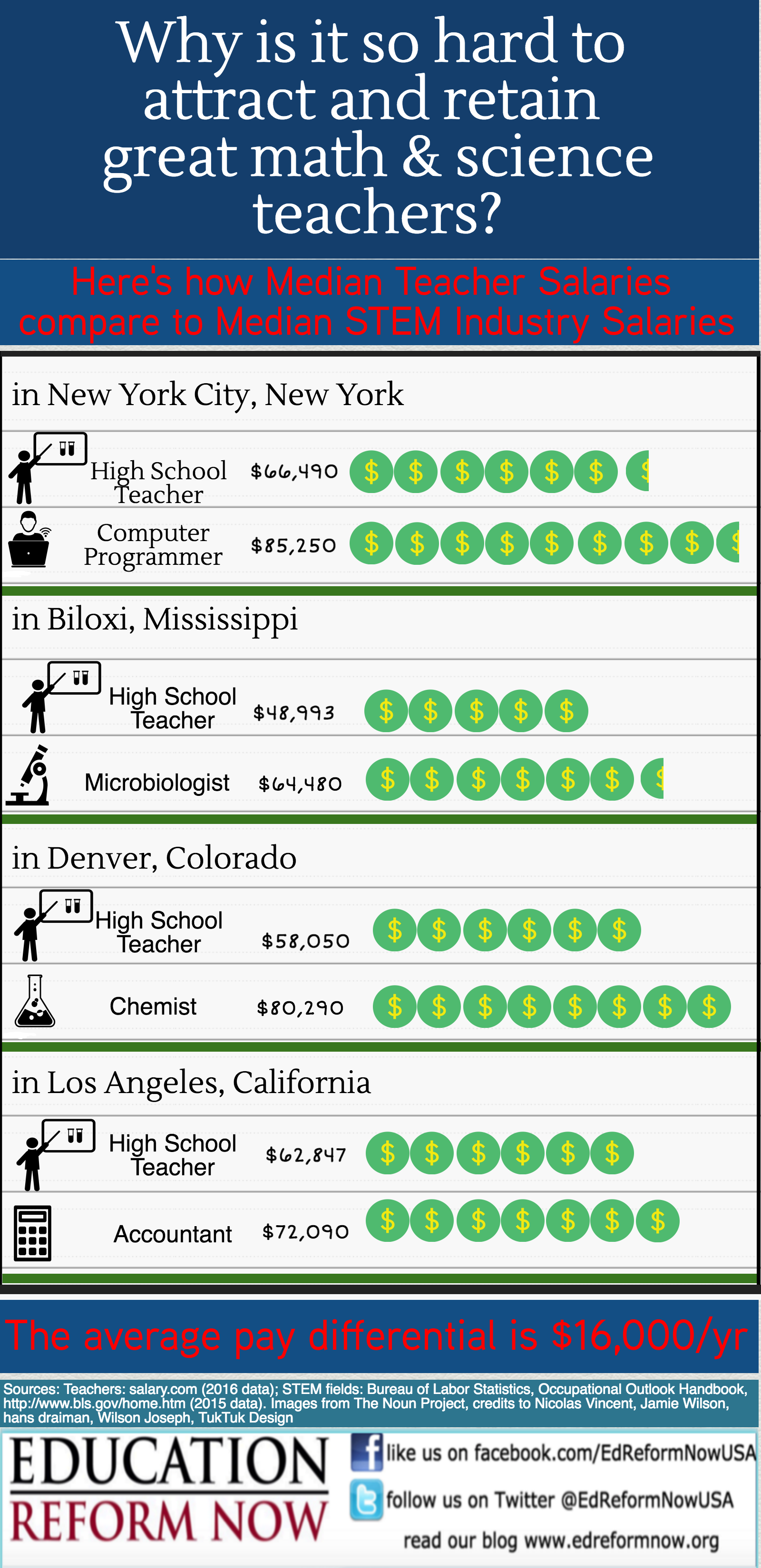This is Part 5 of a blog series responding to renewed interest in teacher pay. We’re featuring infographics to convey what we know about teacher pay and its relationship to ensuring equal education opportunity for all students.
Read Part 1 here, Part 2 here, Part 3 here, and Part 4 here.
In previous posts in this series, we’ve looked at teacher pay systems that reward effectiveness (Part 1 here), that use differentials to retain great teachers in high-poverty and other high-need schools (Part 2 here and Part 3 here), and that deploy differentials tied to excellence in athletics but not in academic subjects (Part 4 here).
Today, we look at compensation – or more accurately the lack thereof – adjusted to compete with other occupational sectors for individuals that have expertise in science, technology, engineering and math (STEM). Ideally, differentiated compensation would help the education sector can attract and retain teachers with high-demand STEM knowledge and skills.
For example, an organization called “Change the Equation” recently compiled information on the contrast between demand for workers in computer science and available coursework in high schools. They concluded:
Jobs in computing are widespread, they are multiplying far faster than in other fields, and they pay much more, yet only 22 percent of U.S. 12th-graders say they have ever taken a computer programming class. More than half couldn’t take such a class if they wanted to, because their high schools don’t offer any. Students of color, low-income students, and rural students fare worst of all.
Surely, the demand for those in the workforce with STEM skills contributes to teacher shortages in STEM subjects, especially given the pay gaps between STEM jobs in and outside of our nation’s public schools. How wide are those gaps? The New Teacher Project’s Shortchanged: The Hidden Cost of Teacher Lockstep Pay, using 2013 data, showed that while starting salaries for biologists are similar to biology teachers, salaries for biologists grow much more quickly so that late-career teachers get paid $26,000 less per year than late-career biologists.
While it may not be surprising that teachers with STEM expertise would get paid more in occupations outside teaching – as opposed to those teaching social studies, for example – one study found that STEM teachers were actually paid less than other teachers in other subjects! Science teachers, for example, were paid 2.9 percent less than non-science teachers and math teachers were paid 4.5 percent less than non-math teachers. This is because teachers get paid based on years of service and credential, not on subject matter or need. Math and science teachers tend to be less experienced and have higher turnover rates.
In fact, a study by Richard Ingersoll found that what seems at first glance to be shortages in the overall supply of teachers may be more a result of teachers in high-demand subjects like STEM leaving prematurely:
In short, this analysis suggests that recruiting more teachers will not solve staffing inadequacies if large numbers of such teachers then leave teaching long before retirement. Again, the turnover of mathematics and science teachers is an especially important issue to address because these fields do not have the same large “cushion” of new teacher supply enjoyed by fields such as English.
We took a look at recent salary data and found these same patterns. See below for the wide gaps between the median salaries of teachers and other professionals in STEM fields.
Despite the now several analyses that have demonstrated these large differentials, the most recent National Center for Education Statistics Schools and Staffing Survey shows that only 13 percent of all school districts permit additional pay to attract or retain great teachers in fields of shortage.
With such disparate income opportunities and a shortage of STEM teachers, it makes sense to recognize the difference in market value of a STEM degree and pay these teachers a commensurate differential. Perhaps if people could see the higher pay opportunity in a STEM teaching career, we could attract more STEM professionals to the education sector and tackle the real teacher shortages facing our nation’s public schools.

